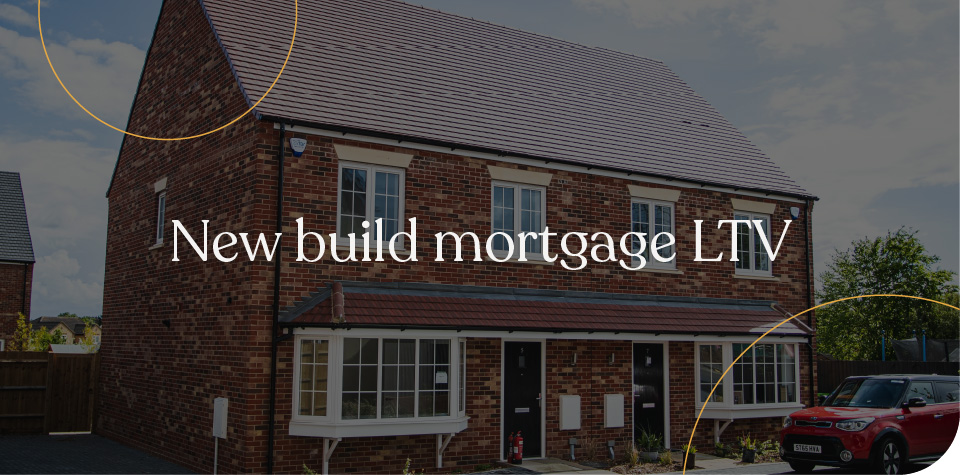
New build mortgage loan to Value – What are your options?
There are many great reasons to buy a new home; for many homeowners, the appeal of buying a new build property greatly outweighs buying an older one.
New build homes allow you the freedom to create the perfect home to your styles and tastes, as well as enjoy a more energy efficient lifestyle. But buying one presents challenges, such as strict lending policies.
While buying a new build home is worth the effort for many people, there is a lot to learn before getting started. More specifically, loan-to-value (LTV) is a vital factor that homebuyers need to be conscious of when applying for a new build mortgage.
The LTV of a mortgage can make all the difference when a mortgage provider decides whether to approve or refuse a mortgage application.
Get approved for a new build mortgage in just 24 hours, start now below:
Get started online
What is Loan to value (LTV) and why is it important?
If you’re in the market for a property and looking to take out a mortgage, you’ll find mortgage brokers and lenders referring to a loan-to-value (LTV) ratio. This is the size of a loan (expressed as a percentage) compared to the value of a property you’re planning to buy.
For example, if you buy a house for £100,000 and pay a deposit of £10,000 or 10%, you can order an LTV of 90% (£90,000 is what you’re borrowing).
LTV ratio is one of the most important factors in determining the eligibility for securing a loan, as well as which loan you can take out and how much it will cost you. LTV and equity are the main drivers for property price, so as your equity increases, you begin to qualify for better deals.
However, securing a mortgage for a new build property can be more complex than it appears. Some lenders can be wary of lending larger amounts of money for new builds because they are harder to assess, and the property value may fall in its early years. And from the perspective of a lender, there is no guarantee a homeowner can repay their mortgage for a new build.
This is why it is important to put down a larger deposit. Typically, the higher the deposit you can place, means you’ll qualify for a better mortgage deal, as lenders are more likely to see you as risk-free. Some lenders can be unwilling to lend larger amounts of money, especially for new builds.
A low LTV means you own a larger piece of the property. A high LTV means you own a smaller piece of the property and the riskier you are to mortgage lenders.
While finding a new build mortgage with a high LTV can be difficult for new build properties, it is not impossible.
We are expert mortgage brokers
We have access to over 200 lenders in the UK to get you the best rates
Start your application here
How Lenders Use LTV
Most lenders will offer the lowest possible interest rate when a mortgage applicant’s LTV is at 80% or below. A higher LTV will mean the interest on the loan may rise; however, this does not exclude mortgage borrowers from being approved.
For example, a borrower with a 95% LTV may have their interest rate rise by a full percentage point higher than a borrower with a 75% LTV.
Lower LTVs are better in the eyes of mortgage lenders but require borrowers to come up with larger down payments.
What is considered a good LTV by lenders?
While there is no “good” LTV, most lenders have limits for the maximum loan-to-value they will allow. In many cases, the ideal LTV ratio should be anywhere below 80%.
Lenders prefer to see LTVs at 80% or below, as anything above is considered a high LTV and riskier for them. However, many new build mortgages are available for people with LTVs at 90% or even 95%, but you’ll be paying much more on interest.
Nevertheless, these deals are not very common and often involve buying under certain conditions, like the government Help to Buy scheme which will be discussed later.
Get started online
Why is LTV Lower for New Build Houses?
The approach to new build homes varies from lender to lender; some may be happy to loan, while others refuse applications.
When buying a new build home as opposed to an older one, you’ll find that most mortgage lenders are less willing to lend at high LTV ratios.
Although a new build property holds its value for all manner of reasons, not least because they are energy efficient and low maintenance, securing a mortgage for one can be much more difficult than for an older/lived-in property.
For some lenders, new builds pose a risk because of the pricing of the new build and how well the property price of a new home will hold relative to the market over time. A home bought with a 90% mortgage would only have to lose 11% of its value to go into ‘negative equity’. This is when the value of the property falls below the outstanding balance.
Thus, lenders will insist on stricter terms if you have a high LTV ratio, meaning higher interest rates and potentially higher fees. Ultimately lower LTVs are better in the eyes of mortgage lenders, and they’ll offer the most attractive mortgage deals to these low LTV customers.
Additionally, new build properties that aren’t completed can make lenders even more reluctant to lend. This is because lenders cannot fully assess the property’s standard, meaning it’s harder for the mortgage lender to calculate how much they could potentially resell the property for. Property prices are notorious for fluctuating, and this makes lenders cautious.
Thus, if you can afford a higher but reasonable deposit, the LTV will be lower and can work out better in the long run for you and the lender.
Get started online
What Can Affect an LTV Rate for a New Build?
Lenders want assurance that they will not lose money by lending to you. Factors such as a bad credit score, low income, and unreliable employment pose a risk to lenders, thus affecting your LTV.
For example, applying for a mortgage with bad credit means that lenders will regard your mortgage application as high-risk and lower your LTV rate to ensure they’re not putting themselves at risk of losing money.
LTV & first-time buyers
For first-time buyers, saving up for a large deposit can be difficult, and the LTV can quickly become a concern, leading them to opt for a higher LTV. But a high LTV carries risk, so first-time buyers should weigh whether it makes financial sense to enter the property ladder with a minimum deposit.
Rather than wait and save up for a larger deposit, it is recommended to secure a better mortgage deal. However, an equity loan scheme can help, particularly the government-backed Help to Buy equity loan scheme. This loan scheme helps first-time buyers secure a 95% LTV mortgage on a new build property.
The Help to Buy equity loan provides up to 20% (40% in London) of the value of a new build home that’s interest-free for five years, meaning first time buyers have the freedom to take a 75% LTV mortgage, which is more readily available than a 95% LTV mortgage and has better terms.
Get started online
Can you get a 95-100% new build mortgage?
While securing a mortgage with a 95% or 100% LTV is rare, it is possible to find a lender for a new build willing to offer this deal. However, be aware that very few lenders are willing to do this.
The eligibility criteria for a 95% or 100% mortgage might be more strict since lending to a borrower who only has a small deposit to put down often means the mortgage provider is taking on extra risk.
Although some lenders may offer mortgages with as little as a 5% deposit, it is important to understand that the interest rates on these loans will be much higher to account for the risk involved.
Is it possible to secure a mortgage for a new build that is a ‘Non-Standard’ Construction?
While most homes fall under ‘standard construction’, several properties in the UK are categorised as non-standard construction based on the materials and techniques used to build them, such as a steel-framed house or thatched cottage.
Non-standard properties are harder to finance because lenders consider them a higher risk.
A non-standard property can be expensive to repair and maintain if the materials used are harder to source or finance. However, due to so many non-standard property types, not all are categorised as equal in terms of risk.
Certain non-standard property types are preferred over others by lenders.
Get started online
How do you find lenders that offer the best LTV rates for new build mortgages?
Getting a foot on the property ladder and finding the best deal on your mortgage for new build homes can be tough. To find the best LTV rate, you should speak with a mortgage broker.
Seeking professional mortgage advice about your new build mortgage application is crucial to the success of your application.
Mortgage brokers can assess your situation and suggest lenders suitable for you. They can find lenders willing to accept your application even in unique instances, such as a bad credit record or a desire to purchase a certain type of property.
Ultimately, going through a mortgage broker ensures your mortgage application is in pristine condition and ready for the lender to review, all while saving you time and money.
Get the best new build mortgage advice today with Loan Corp
If you need help finding a new build mortgage lender who can save you time and money, your search ends here. At Loan Corp, we can help make your dream of buying a new build property a reality.
Whether you’re simply looking for expert advice or have questions about which mortgage lenders have the best LTV for new builds, our expert brokers can help.
All you have to do is make an enquiry with us and one of our brokers with the right expertise will contact you to help you find the best solution.
Get started online
FAQs
How to calculate LTV?
To calculate your LTV ratio, divide your current loan balance (the amount borrowed) by the current appraised value of the property, and then multiply by 100 to convert this number to a percentage.
Does LTV affect interest rate?
LTV significantly affects a borrower’s interest rate. A low LTV means you’re borrowing less while investing more money into the home you’re buying. Lenders favour this, which can lead to a lower interest rate. A high LTV can lead to a high interest rate.
Do lower LTVs mean better rates?
People borrowing at 75% LTV or lower can access better mortgage deals than those with smaller deposits (higher LTVs).
How can you lower an LTV?
You can lower your LTV by making a larger down payment on the property or reducing the amount of money you need to borrow.
Get started online